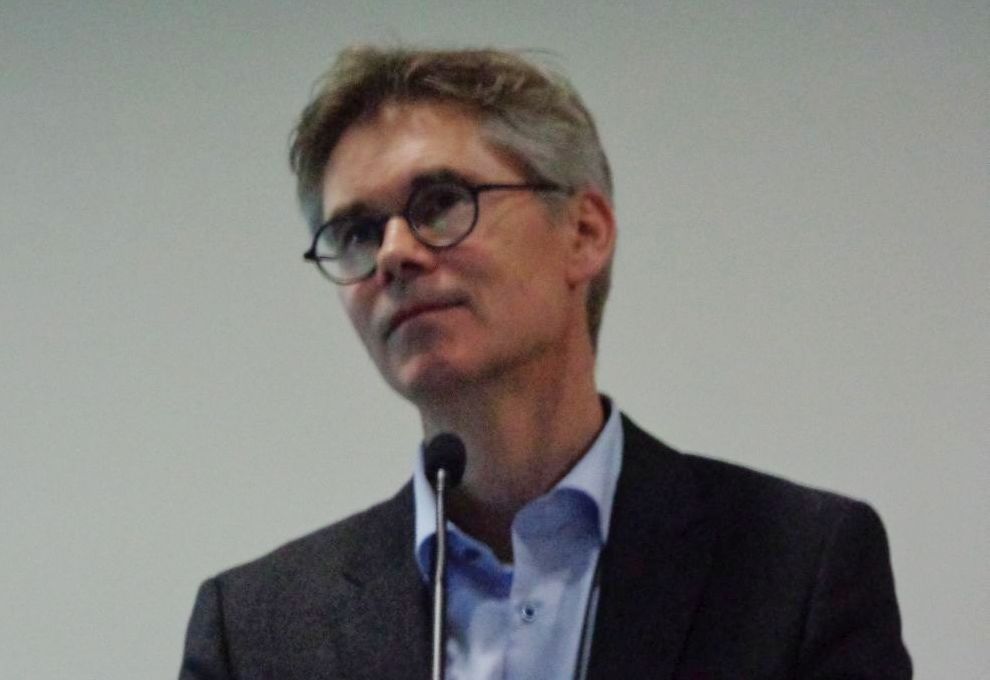User login
SAN DIEGO, CA – A public health program in Iceland is on schedule to eliminate the potential for hepatitis C virus (HCV) transmission by curing all infected patients, according to a progress report presented at ID Week 2017.
“Our results are from a real-world setting, where the difficult-to-treat patients are actually prioritized,” explained Magnus Gottfredsson, MD, PhD, an infectious disease specialist affiliated with the National University Hospital, Reykjavik, Iceland.
“If we only scaled up treatment, we would not reach the goal of eliminating HCV infection. We needed something else,” Dr. Gottfredsson explained. This something else has been to reach out aggressively to those most likely to transmit disease. The multidisciplinary test-and-treat program engages physicians, nurses, and those providing psychosocial support across a variety of settings, including those involving addiction treatment, prison administration, and homeless outreach.
Of the 480 patients treated so far in the program, which offers treatment to all HCV-infected patients 16 years of age or older, Dr. Gottfredsson presented followup data on 322. All treatment is based on the direct acting antiviral (DAA) combination of sofosbuvir/ledipasvir (sof/ldv), usually given for 8 to 12 weeks. In selected cases, such as in HCV-infected patients with cirrhosis, patients also receive ribavirin. Gilead, the manufacturer of sof/ldv, has donated the therapy for the initial phase of the program.
Of the 322 patients treated, 298 patients completed therapy in accordance with the protocol and all were negative for HCV on polymerase chain reaction (PCR) testing at the end of treatment. When re-evaluated 12 weeks after treatment was completed, 6% were HCV positive. It is believed that most or all of these represented reinfection.
Of the 24 patients who did not complete therapy, 2 died and 19 were initially lost to follow-up. However, an intensive search was launched to locate the missing patients, and 17 of 19 were located. When evaluated with PCR, half were negative. As a result, the outcomes to data on an intention-to-treat analysis are 90% PCR negative, 8% still HCV positive and presumed reinfected, and 2% deceased or missing.
All of those who are reinfected have been or will be retreated.
“We prioritize those who are reinfected for retreatment because they are the individuals at greatest risk of transmitting infection,” Dr. Gottfredsson explained.
The rate of success is encouraging, because one third of the patients treated so far are active drug users. Of the 322 patients treated, 11% were living in halfway houses, 6% were homeless, and 5% were in prisons. One third of all DAA prescriptions in the TraP HepC program have been written by clinicians working in addiction medicine. The high rate of success was achieved despite the fact that 48% of HCV infections were genotype 3A virus, which is not the most responsive genotype to the DAAs offered.
Due to the presence of universal healthcare and universal HCV reporting, Iceland may be in an exceptional position to reduce HCV transmission to zero. Like many countries in northern Europe, the estimated prevalence of HCV is approximately 0.3%, which is 70% lower than that of the United States.
The World Health Organization has set a goal of a 90% reduction in the incidence of HCV by the year 2030, but Iceland is on track to eradicate HCV infection completely or nearly completely by the end of next year. If achieved, it will prevent transmission and produce 100% reduction in the incidence of HCV by 2019.
However, Dr. Gottfredsson acknowledged that treating all individuals currently infected with HCV in Iceland does not eliminate the threat of new cases and new transmissions. While he reported that procedures for routine screening of refugees and foreign workers are already in place, tourists and other visitors remain a potential source of new infections and a need for continued surveillance. Dr. Gottfredsson reports financial relationships with Astellas and Gilead.
SAN DIEGO, CA – A public health program in Iceland is on schedule to eliminate the potential for hepatitis C virus (HCV) transmission by curing all infected patients, according to a progress report presented at ID Week 2017.
“Our results are from a real-world setting, where the difficult-to-treat patients are actually prioritized,” explained Magnus Gottfredsson, MD, PhD, an infectious disease specialist affiliated with the National University Hospital, Reykjavik, Iceland.
“If we only scaled up treatment, we would not reach the goal of eliminating HCV infection. We needed something else,” Dr. Gottfredsson explained. This something else has been to reach out aggressively to those most likely to transmit disease. The multidisciplinary test-and-treat program engages physicians, nurses, and those providing psychosocial support across a variety of settings, including those involving addiction treatment, prison administration, and homeless outreach.
Of the 480 patients treated so far in the program, which offers treatment to all HCV-infected patients 16 years of age or older, Dr. Gottfredsson presented followup data on 322. All treatment is based on the direct acting antiviral (DAA) combination of sofosbuvir/ledipasvir (sof/ldv), usually given for 8 to 12 weeks. In selected cases, such as in HCV-infected patients with cirrhosis, patients also receive ribavirin. Gilead, the manufacturer of sof/ldv, has donated the therapy for the initial phase of the program.
Of the 322 patients treated, 298 patients completed therapy in accordance with the protocol and all were negative for HCV on polymerase chain reaction (PCR) testing at the end of treatment. When re-evaluated 12 weeks after treatment was completed, 6% were HCV positive. It is believed that most or all of these represented reinfection.
Of the 24 patients who did not complete therapy, 2 died and 19 were initially lost to follow-up. However, an intensive search was launched to locate the missing patients, and 17 of 19 were located. When evaluated with PCR, half were negative. As a result, the outcomes to data on an intention-to-treat analysis are 90% PCR negative, 8% still HCV positive and presumed reinfected, and 2% deceased or missing.
All of those who are reinfected have been or will be retreated.
“We prioritize those who are reinfected for retreatment because they are the individuals at greatest risk of transmitting infection,” Dr. Gottfredsson explained.
The rate of success is encouraging, because one third of the patients treated so far are active drug users. Of the 322 patients treated, 11% were living in halfway houses, 6% were homeless, and 5% were in prisons. One third of all DAA prescriptions in the TraP HepC program have been written by clinicians working in addiction medicine. The high rate of success was achieved despite the fact that 48% of HCV infections were genotype 3A virus, which is not the most responsive genotype to the DAAs offered.
Due to the presence of universal healthcare and universal HCV reporting, Iceland may be in an exceptional position to reduce HCV transmission to zero. Like many countries in northern Europe, the estimated prevalence of HCV is approximately 0.3%, which is 70% lower than that of the United States.
The World Health Organization has set a goal of a 90% reduction in the incidence of HCV by the year 2030, but Iceland is on track to eradicate HCV infection completely or nearly completely by the end of next year. If achieved, it will prevent transmission and produce 100% reduction in the incidence of HCV by 2019.
However, Dr. Gottfredsson acknowledged that treating all individuals currently infected with HCV in Iceland does not eliminate the threat of new cases and new transmissions. While he reported that procedures for routine screening of refugees and foreign workers are already in place, tourists and other visitors remain a potential source of new infections and a need for continued surveillance. Dr. Gottfredsson reports financial relationships with Astellas and Gilead.
SAN DIEGO, CA – A public health program in Iceland is on schedule to eliminate the potential for hepatitis C virus (HCV) transmission by curing all infected patients, according to a progress report presented at ID Week 2017.
“Our results are from a real-world setting, where the difficult-to-treat patients are actually prioritized,” explained Magnus Gottfredsson, MD, PhD, an infectious disease specialist affiliated with the National University Hospital, Reykjavik, Iceland.
“If we only scaled up treatment, we would not reach the goal of eliminating HCV infection. We needed something else,” Dr. Gottfredsson explained. This something else has been to reach out aggressively to those most likely to transmit disease. The multidisciplinary test-and-treat program engages physicians, nurses, and those providing psychosocial support across a variety of settings, including those involving addiction treatment, prison administration, and homeless outreach.
Of the 480 patients treated so far in the program, which offers treatment to all HCV-infected patients 16 years of age or older, Dr. Gottfredsson presented followup data on 322. All treatment is based on the direct acting antiviral (DAA) combination of sofosbuvir/ledipasvir (sof/ldv), usually given for 8 to 12 weeks. In selected cases, such as in HCV-infected patients with cirrhosis, patients also receive ribavirin. Gilead, the manufacturer of sof/ldv, has donated the therapy for the initial phase of the program.
Of the 322 patients treated, 298 patients completed therapy in accordance with the protocol and all were negative for HCV on polymerase chain reaction (PCR) testing at the end of treatment. When re-evaluated 12 weeks after treatment was completed, 6% were HCV positive. It is believed that most or all of these represented reinfection.
Of the 24 patients who did not complete therapy, 2 died and 19 were initially lost to follow-up. However, an intensive search was launched to locate the missing patients, and 17 of 19 were located. When evaluated with PCR, half were negative. As a result, the outcomes to data on an intention-to-treat analysis are 90% PCR negative, 8% still HCV positive and presumed reinfected, and 2% deceased or missing.
All of those who are reinfected have been or will be retreated.
“We prioritize those who are reinfected for retreatment because they are the individuals at greatest risk of transmitting infection,” Dr. Gottfredsson explained.
The rate of success is encouraging, because one third of the patients treated so far are active drug users. Of the 322 patients treated, 11% were living in halfway houses, 6% were homeless, and 5% were in prisons. One third of all DAA prescriptions in the TraP HepC program have been written by clinicians working in addiction medicine. The high rate of success was achieved despite the fact that 48% of HCV infections were genotype 3A virus, which is not the most responsive genotype to the DAAs offered.
Due to the presence of universal healthcare and universal HCV reporting, Iceland may be in an exceptional position to reduce HCV transmission to zero. Like many countries in northern Europe, the estimated prevalence of HCV is approximately 0.3%, which is 70% lower than that of the United States.
The World Health Organization has set a goal of a 90% reduction in the incidence of HCV by the year 2030, but Iceland is on track to eradicate HCV infection completely or nearly completely by the end of next year. If achieved, it will prevent transmission and produce 100% reduction in the incidence of HCV by 2019.
However, Dr. Gottfredsson acknowledged that treating all individuals currently infected with HCV in Iceland does not eliminate the threat of new cases and new transmissions. While he reported that procedures for routine screening of refugees and foreign workers are already in place, tourists and other visitors remain a potential source of new infections and a need for continued surveillance. Dr. Gottfredsson reports financial relationships with Astellas and Gilead.
ID WEEK 2017
Key clinical point:
Major finding: Just 20 months into the program, there has been a nearly 50% reduction in HCV infections, and the plan is to reach all patients by end of 2018.
Data source: Update on national public health initiative.
Disclosures: Dr. Gottfredsson reports financial relationships with Astellas and Gilead.

